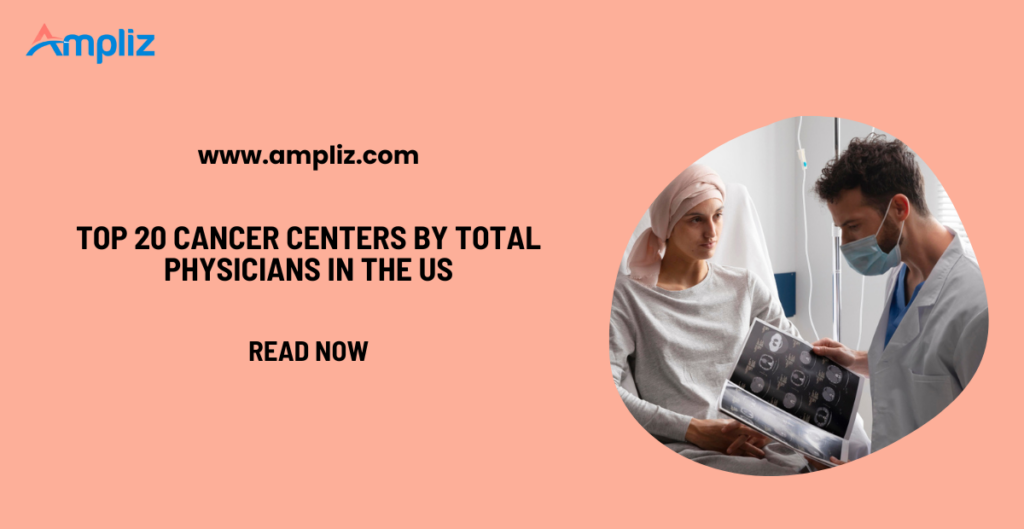Cancer care in the United States continues to evolve with cutting-edge technology, multidisciplinary teams, and a focus on personalized treatment. While survival rates and research innovation are important benchmarks, the total number of physicians at a cancer center serves as a critical indicator of its capacity, scalability, and capability to offer specialized care.
In this blog, we dive into the top 20 cancer centers in the US by total physician count, providing insights into why this metric matters, how to use it strategically in healthcare outreach, and how platforms like Ampliz can help you connect with these institutions.
Why Physician Count Matters in Cancer Centers
Cancer treatment is rarely handled by a single doctor. It requires a collaborative network of oncologists, radiologists, pathologists, surgeons, palliative care experts, and research specialists. The larger the physician pool, the more specialized and personalized care a facility can offer.
High physician counts also imply:
- Better patient-to-doctor ratios
- Faster access to care
- Increased capacity for clinical trials
- Enhanced research and academic activity
Whether you’re a patient, researcher, or healthcare marketer, knowing which centers house the most physicians can guide critical decisions.
Methodology for Ranking
To determine the top 20 cancer centers by total physicians, we analyzed:
- Publicly available data from hospital and cancer center websites
- Annual physician rosters and hospital reports
- National Cancer Institute (NCI) designation statuses
- Affiliated university medical schools
This list includes both freestanding cancer hospitals and academic medical centers with dedicated cancer institutes.
Top 20 Cancer Centers in US by Total Physicians
Here’s a ranked list based on the most recent data (2024–2025):
| Rank | Cancer Center Name | Location | Total Physicians | NCI-Designation | Affiliation | Dataset |
|---|---|---|---|---|---|---|
| 1 | MD Anderson Cancer Center | Houston, TX | 1,800+ | Yes | University of Texas | Access Now |
| 2 | Memorial Sloan Kettering Cancer Center | New York, NY | 1,500+ | Yes | Weill Cornell | Access Now |
| 3 | Dana-Farber Cancer Institute | Boston, MA | 1,300+ | Yes | Harvard University | Access Now |
| 4 | Mayo Clinic Cancer Center | Rochester, MN | 1,250+ | Yes | Mayo Clinic | Access Now |
| 5 | Cleveland Clinic Taussig Cancer Institute | Cleveland, OH | 1,100+ | Yes | Cleveland Clinic | Access Now |
| 6 | UCSF Helen Diller Family Comprehensive Cancer Center | San Francisco, CA | 1,050+ | Yes | University of California | Access Now |
| 7 | Fred Hutchinson Cancer Center | Seattle, WA | 1,000+ | Yes | University of Washington | Access Now |
| 8 | Johns Hopkins Sidney Kimmel Comprehensive Cancer Center | Baltimore, MD | 950+ | Yes | Johns Hopkins University | Access Now |
| 9 | University of Michigan Rogel Cancer Center | Ann Arbor, MI | 900+ | Yes | University of Michigan | Access Now |
| 10 | City of Hope Comprehensive Cancer Center | Duarte, CA | 875+ | Yes | City of Hope National Medical Center | Access Now |
| 11 | UCLA Jonsson Comprehensive Cancer Center | Los Angeles, CA | 850+ | Yes | UCLA | Access Now |
| 12 | Northwestern Medicine Robert H. Lurie Cancer Center | Chicago, IL | 800+ | Yes | Northwestern University | Access Now |
| 13 | UPMC Hillman Cancer Center | Pittsburgh, PA | 750+ | Yes | University of Pittsburgh | Access Now |
| 14 | Emory Winship Cancer Institute | Atlanta, GA | 720+ | Yes | Emory University | Access Now |
| 15 | Massachusetts General Hospital Cancer Center | Boston, MA | 700+ | Yes | Harvard Medical School | Access Now |
| 16 | University of Pennsylvania Abramson Cancer Center | Philadelphia, PA | 675+ | Yes | University of Pennsylvania | Access Now |
| 17 | University of Colorado Cancer Center | Aurora, CO | 650+ | Yes | University of Colorado | Access Now |
| 18 | Indiana University Melvin and Bren Simon Comprehensive Cancer Center | Indianapolis, IN | 620+ | Yes | Indiana University | Access Now |
| 19 | Moffitt Cancer Center | Tampa, FL | 600+ | Yes | University of South Florida | Access Now |
| 20 | Huntsman Cancer Institute | Salt Lake City, UT | 580+ | Yes | University of Utah | Access Now |
Regional Trends in Cancer Care Staffing
Most top cancer centers are located in major metro areas on the East Coast, West Coast, and Midwest. These regions benefit from:
- Proximity to academic institutions
- Robust biotech ecosystems
- Strong federal research funding
For instance, the Northeast corridor (Boston, New York, Philadelphia) is home to a high concentration of top-tier cancer hospitals with thousands of physicians involved in patient care, research, and education.
Why Marketers & Sales Teams Should Care
For companies targeting cancer hospitals — whether in medical devices, pharmaceuticals, diagnostics, or SaaS healthcare solutions — understanding physician density is vital.
Benefits of targeting cancer centers with high physician counts:
- Larger networks of decision-makers and stakeholders
- Higher budgets and treatment volumes
- Opportunities to pilot innovative technologies
- Better scalability for product rollouts
It allows you to segment your total addressable market (TAM) and optimize outreach efforts with precision.
Using Hospital Data to Target High-Volume Cancer Centers
To connect with these top hospitals, you need more than a name—you need verified data on:
- Individual physician specialties
- Department heads and administrative leaders
- Contact information (email, phone, location)
- Affiliation and NPI number
- Role in clinical trials or research
Platforms like Ampliz offer healthcare data solutions that make this possible.
Why Use Ampliz for Reaching Cancer Centers?
Ampliz gives you access to:
- Filtered physician lists from top oncology hospitals
- Hospital-level analytics including staff size, budget, and department mapping
- Real-time data enrichment to avoid outdated contacts
- HIPAA-compliant data handling
Whether you’re planning a multi-touch ABM campaign or need leads for oncology product sales, Ampliz helps you shorten your sales cycle and improve ROI.
Conclusion
Cancer centers with the highest number of physicians are not only medical giants — they’re also powerful ecosystems for innovation, collaboration, and commercialization. For marketers, data providers, and vendors, understanding this staffing dynamic is key to intelligent outreach.
Want to get direct access to the physicians and decision-makers at these top 20 cancer hospitals?
👉 Request a custom list from Ampliz and start your outreach today.
FAQs
1. What is the largest cancer center in the US by physician count?
MD Anderson Cancer Center in Houston, TX is widely recognized as the largest, with over 1,800 physicians on staff.
2. Why does the number of physicians matter in cancer hospitals?
More physicians indicate broader specialization, faster treatment access, higher patient capacity, and better clinical trial infrastructure.
3. How do I get contact data for these top cancer centers?
You can use healthcare data platforms like Ampliz to access verified physician and hospital data by role, specialty, and location.
4. What is the benefit of targeting high-physician-count cancer centers?
They are better equipped to evaluate and adopt new technologies, making them ideal targets for product launches and partnerships.
5. Are all top cancer centers NCI-designated?
Yes, most of the top cancer hospitals listed are NCI-designated comprehensive cancer centers, indicating a high level of research and care excellence.



